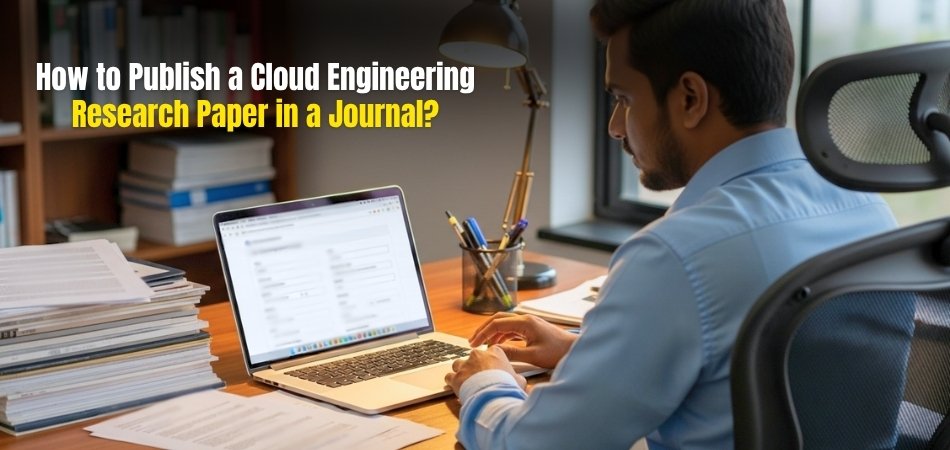Getting a cloud engineering research paper published in a journal is a proud moment for many. It means your ideas matter and can help others in the field. If you’ve been working on a smart solution or a useful cloud tool, you might be thinking about how to publish a cloud engineering research paper in a journal.
To publish a cloud engineering research paper, start by choosing a clear topic and doing thorough research. Plan and write your paper using simple language. Check and edit it carefully. Then, pick the right journal that fits your topic, follow their submission rules, and send your paper online. Be patient while waiting for feedback, and make changes if needed before final acceptance.
Want to know the full process and what to watch out for? Keep reading—this guide has all the steps you need to understand from beginning to end.
How to Publish a Cloud Engineering Research Paper in a Journal?
Publishing a cloud engineering research paper in a journal may sound difficult, but it can be easy if you break it down into simple steps. Many people share their ideas and research this way. Let’s learn how you can do it too.

Pick a Good Topic
Start by choosing a topic that you find interesting. It should be something about cloud engineering, like how cloud storage works or how apps run on the cloud. Make sure there is enough information available so you can understand it better. A good topic will help you stay focused and enjoy writing. Try not to choose something too hard or too easy. Your topic is the first and most important part of your paper.
Do Some Research
After choosing your topic, it’s time to learn more about it. Read websites, watch videos, or look at books that explain your topic in a simple way. Try to understand the main points and how things work. Write down the important things you learn. Keep all your notes in one place so you don’t lose them. This will help you later when you start writing your paper.
Plan Your Paper
Before writing, it’s a good idea to plan what you want to say. Make a list or outline of the points you will include in your paper. Think about what will go in the beginning, middle, and end. Planning helps your paper look neat and easy to read. It also saves time and helps you stay on track. A strong plan makes writing much easier.
Write the Paper
Start your paper with a short introduction to your topic. In the middle, explain your main points one by one. Use simple words so everyone can understand what you are saying. Don’t forget to include what you learned during your research. In the end, write a small conclusion that explains what your paper was about. Keep your writing clear and easy to read.
Check and Edit
Once your paper is done, take some time to check it again. Look for spelling mistakes and fix sentences that sound confusing. Make sure everything makes sense from start to finish. You can also ask someone to read your paper and give feedback. Their advice can help you make your paper better. Good editing helps your paper look clean and professional.
Pick the Right Journal
There are many journals where you can send your paper, but not all of them are the same. Choose one that accepts papers about cloud engineering. Visit the journal’s website and read its rules for sending papers. Some journals are free, and some may ask for money to publish. You can also check events like conferences in USA or other countries, where many good journals are linked or suggested. Picking the right journal gives your paper a better chance.
Send Your Paper
When your paper is ready, go to the journal’s website and look for the place to upload it. Some journals ask you to create an account before sending your paper. After you upload, you may have to wait a few weeks for a reply. Don’t worry if they ask you to fix something and send it again. This is a normal part of the process. Just follow their instructions and stay patient.
Wait for Feedback
After sending your paper, the journal team will read and check it. They will let you know if they accept it, reject it, or want changes. If they ask for changes, read their comments carefully and fix your paper. This helps make your work better and ready for publishing. Don’t feel sad if it’s not accepted the first time. You can always try again or send it to another journal.
Formatting and Manuscript Preparation Guidelines for Journals
If you want your research to be accepted by academic journals, you’ll need to follow their formatting and submission guidelines closely. These standards help keep everything consistent and easy to read. Here are the main things you should know before submitting your manuscript.
| Aspect | Description |
| Title Page | Include the manuscript title, author names, affiliations, and the corresponding author’s contact information. |
| Abstract | Provide a concise summary (usually 150–250 words) highlighting the objective, methods, results, and conclusion. |
| Keywords | List 4–6 relevant keywords to help index and retrieve the article efficiently. |
| Manuscript Structure | Common sections include Introduction, Methods, Results, Discussion, and Conclusion (IMRaD format). |
| Font and Spacing | Use a standard font (e.g., Times New Roman, 12 pt), double-spaced, with 1-inch margins on all sides. |
| Referencing Style | Follow the journal’s preferred citation style (e.g., APA, MLA, Chicago, Vancouver) consistently throughout. |
| Figures and Tables | Place each on a separate page with clear titles and legends; cite them in the text appropriately. |
| Ethical Compliance | Include statements on ethics approval, informed consent, and conflict of interest, where applicable. |
| Supplementary Materials | Attach any additional data, appendices, or multimedia files if allowed by the journal. |
| Proofreading and Editing | Carefully review the manuscript for grammar, clarity, and formatting errors before submission. |
Is It Challenging to Find the Right Topic for a Cloud Engineering Research Paper?
Yes, it is challenging to find the right topic for a cloud engineering research paper. The field is wide and always changing, which makes it hard to choose just one strong idea. Many students feel stuck at first because so many topics sound useful and interesting. Without the right focus, the research can feel scattered and hard to finish well.
Finding a topic that fits both current trends and real-world use is not easy. People often ask themselves if their idea is new enough. When trying to find a topic for a Cloud Engineering conference paper, it helps to look at recent issues in cloud tools and systems.
Also, it’s important to choose a topic that you really care about. Passion can drive better work and deeper thinking all through. Good papers come from honest interest, not just trying to impress or follow what others are doing.
Ethical Considerations When Submitting Cloud Engineering Research
Doing research in cloud engineering is exciting, but it also comes with a few important responsibilities. Before sharing any work, it’s good to know what’s right and wrong in the process. These are things that protect your ideas and respect others too. Understanding these points can help you avoid problems later and build good habits. There’s more to explore, so let’s look into it below.
Keep It Original
Always use your own thoughts and ideas when writing research. It’s okay to read and learn from others, but don’t copy them. Original work shows your true effort and helps build trust in your writing. If you use something from another person’s work, make sure to give them credit. Honest writing makes your research stronger and more meaningful.
Avoid Plagiarism
Plagiarism means taking someone else’s words or ideas and pretending they are yours. This is not just unfair but also dishonest. Even copying a small part without giving credit can be a big problem. Always write things in your own way or clearly say where it came from. Using proper quotes or sources is the best way to stay safe.
Don’t Fake Data
Sometimes people feel pressure to show perfect results and make up fake data. But lying about results is never okay. It can mislead others and cause real harm in future work. Research should be based on what really happened, not what you wish had happened. Real data, even if not perfect, is always better than fake numbers.
Right Credit to Authors
If more than one person worked on the paper, each person should get the right credit. Don’t add names of people who didn’t really help. Also, don’t leave out someone who gave real input or ideas. Giving proper credit is fair and shows respect for everyone’s efforts. Teamwork works best when everyone is treated equally.
Check Before Submitting
Before sending your paper to a journal or conference, take time to check everything. Make sure the work is honest, complete, and clear. Look for any mistakes or missing credits. It’s always better to fix things before submission than after. A final check shows that you care about your work.
Follow the Rules
Each place where you submit has its own rules and format. Make sure to read and follow those carefully. Some rules are about how you write, while others are about what you can include. Ignoring rules can lead to rejection or delay. Following them shows respect for the process and your readers.
What to Do If Your Cloud Engineering Paper Gets Rejected
It can be discouraging to have a paper rejected, particularly after investing so much time and energy into it. But rejection doesn’t mean your work is useless or not good. It just means there’s still room to make it better. Don’t give up—there are steps you can take next.
Read the Feedback
Rejection from a cloud engineering journal often includes reviewer comments explaining what went wrong. Use these notes as a guide to improve your work, not as criticism. They can highlight unclear arguments, missing data, or weak analysis. Take time to read carefully and understand the deeper message behind the feedback.
Take a Short Break
Before rushing to fix things, give yourself a short break. Stepping away for a day or two helps clear your mind. When you come back, you can look at the paper with fresh eyes. This makes it easier to spot what needs to change. It also helps you feel less stressed about the rejection.
Make Improvements
After reading the feedback, start working on the parts that need fixing. Maybe you need clearer ideas, better examples, or more proof for your points. Fix spelling, grammar, and anything that might confuse the reader. Take your time and do it right. Each fix makes the paper stronger.
Ask for Help
Sometimes, it’s hard to figure out what went wrong on your own. Asking a friend or someone who knows the topic can really help. They might see mistakes or give tips you didn’t think of. A second opinion can make a big difference. Don’t be afraid to ask questions.
Choose Another Journal
If the paper doesn’t fit one journal, try another that suits your topic better. Every journal has its own style and rules. Just because one says no doesn’t mean the others will. Find one that matches your paper’s idea and format. Keep going—you still have a chance.
Stay Positive Always
Rejection happens to everyone at some point. Even top experts have their papers turned down. What matters is what you do after it. Believe in your work and keep trying. Every step forward brings you closer to success.
Factors to Keep in Mind When Attending a Conference After Publishing a Paper
Attending a conference after your paper is accepted can be exciting and a little stressful at the same time. There’s more to it than just showing up and reading your paper. You’ll meet new people, share ideas, and answer questions. Let’s look at what things you should think about before going.
Know Your Paper Well
Before the conference, read your paper again and understand every part of it. People may ask questions, and you should be ready. Try to explain your work in simple words so everyone can follow. If there are any weak parts, prepare how to explain or fix them. Being confident in your own work is the first step.
Practice Your Talk
Don’t just wait until the day of the conference to speak. Practice talking about your paper in front of a mirror or with a friend. Time yourself so you don’t speak too long or too fast. Try to keep your talk clear and straight to the point. Practice helps you feel less nervous.
Dress Neat and Simple
You don’t need fancy clothes, but you should look neat and clean. Dressing well shows that you take the event seriously. For example, ideal clothing for Cloud Engineering conference in the USA could be a simple shirt, comfortable pants, and clean shoes. Choose something that’s comfortable and makes you feel confident. First impressions do matter, even in simple ways.
Be Ready to Listen
Conferences are not just about your paper. Many others are sharing their work too. Listen to them and ask questions if something interests you. You can learn a lot from other people’s talks. It also shows that you care about more than just your own work.
Talk to People
This is a great time to meet others who like the same topics. Don’t be shy to say hello or ask what they work on. You might make a new friend or even find someone to work with later. Sharing ideas can lead to more good work in the future. Start with small chats and build from there.
Keep Notes Handy
Bring a small notebook or use your phone to write down good ideas. You may hear tips, feedback, or even questions that can help you improve. These notes are easy to forget if you don’t write them. They can help with your next paper or future projects. Little notes today can make a big difference later.
Frequently Asked Questions
There are many steps and details involved when you want your research to reach others through a journal. It’s normal to have questions about the process, what to expect, and how to handle certain situations. These FAQs answer some common concerns to help you feel ready and confident along the way.
What Are Common Mistakes to Avoid When Submitting a Paper?
Many authors rush to submit without carefully following journal rules or thoroughly proofreading their work. Common errors include ignoring formatting guidelines, missing citations, or unclear writing. Avoid these by double-checking everything and reading the submission instructions closely. A clean, well-prepared paper shows professionalism and improves chances of acceptance.
How Important Is the Abstract in My Research Paper?
The abstract is very important because it is the first thing editors and readers see. It summarizes your whole paper in a short, clear way. A good abstract helps people quickly understand your research’s value and decide to read more. Spend time making it clear, concise, and complete.
Can I Submit the Same Paper to Multiple Journals at Once?
No, submitting the same paper to more than one journal at the same time is considered unethical. Journals expect you to send your work to only one at a time to avoid duplication. Wait until you receive a decision before submitting elsewhere. This respects the journal’s time and keeps your reputation strong.
How Long Does the Peer Review Process Usually Take?
The peer review process often takes several weeks to a few months. It depends on the journal, reviewer availability, and paper complexity. During this time, reviewers carefully check your work and suggest improvements or raise concerns. Patience is key while waiting for feedback.
Should I Include Visuals Like Graphs or Diagrams?
Including visuals such as graphs, charts, or diagrams can help explain complex ideas clearly. They make your paper easier to understand and more engaging. Always label them well and refer to them in the text. Make sure visuals add real value and are not just decorative.
How Do I Choose Keywords for My Paper?
Keywords help people find your paper in searches, so choose terms that best describe your topic. Use specific, relevant words that researchers interested in your subject would look for. Avoid very broad or too rare terms. A good set of keywords improves your paper’s visibility.
Is It Necessary to Follow a Specific Citation Style?
Yes, each journal requires a certain citation style like APA, MLA, or Vancouver. Following the correct style shows attention to detail and respects academic standards. Incorrect or inconsistent citations can delay your paper’s acceptance. Always check the journal’s guidelines before submitting.
Conclusion
Publishing your work in a journal is a big step that shows your ideas matter and can help others. It might feel a little confusing at first, but breaking the process into simple parts makes it easier. Knowing what to do from start to finish gives you more confidence.
If you want to learn how to publish a cloud engineering research paper in a journal, remember that choosing the right topic and following the journal’s rules are key. Taking your time to research, write clearly, and check your paper carefully will improve your chances. Don’t be afraid of feedback or even rejection—they are part of getting better.
Keep practicing, stay patient, and use every chance to learn from the process. Soon, your work will reach more people and make a difference. If you’re ready to take the next step, this guide is a helpful start.







